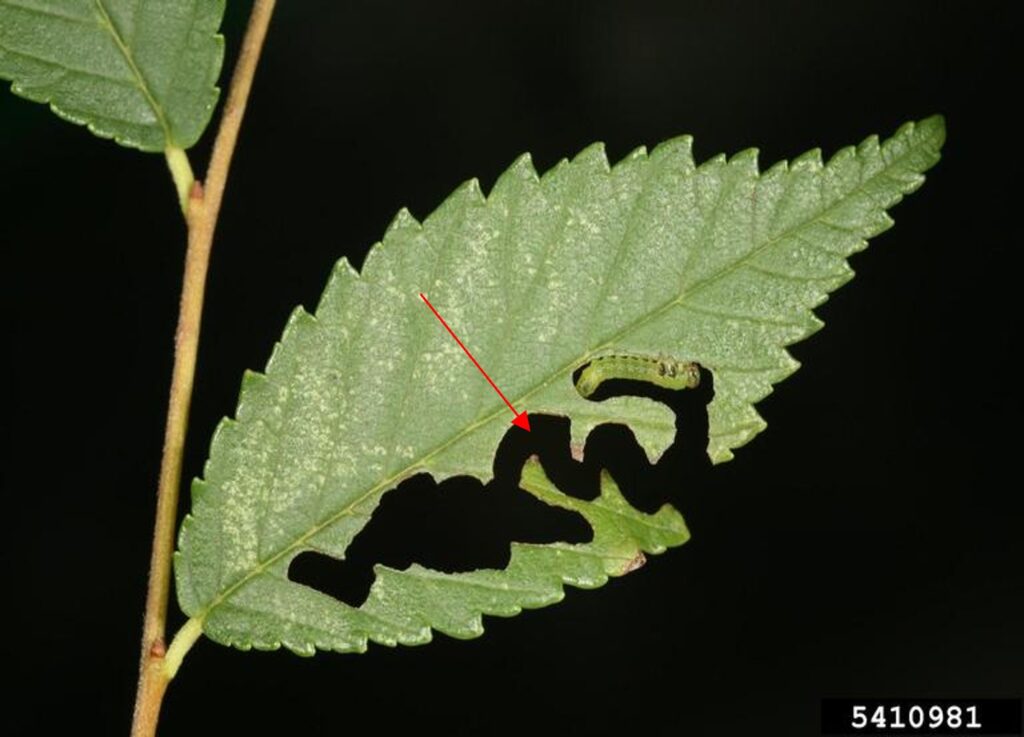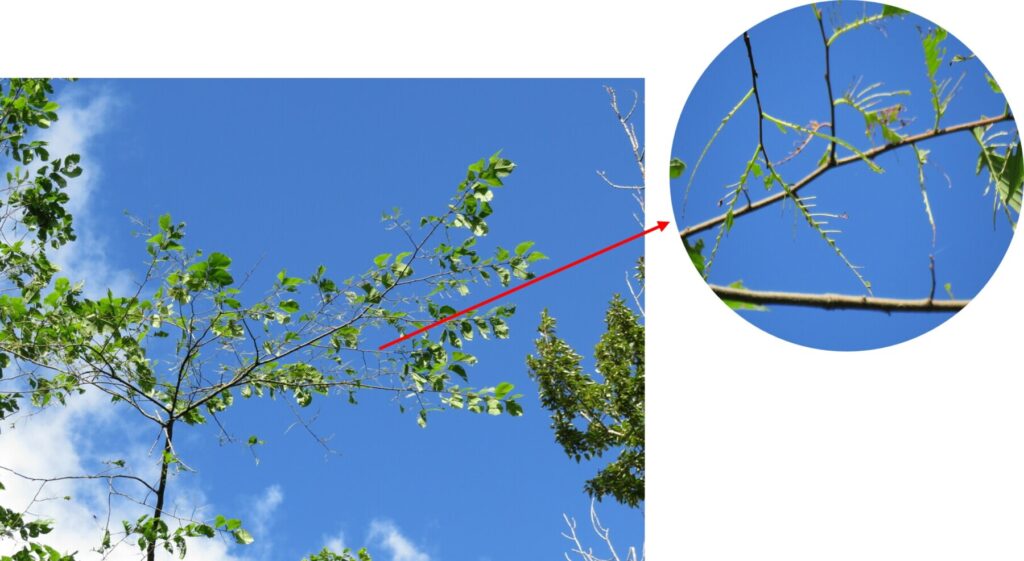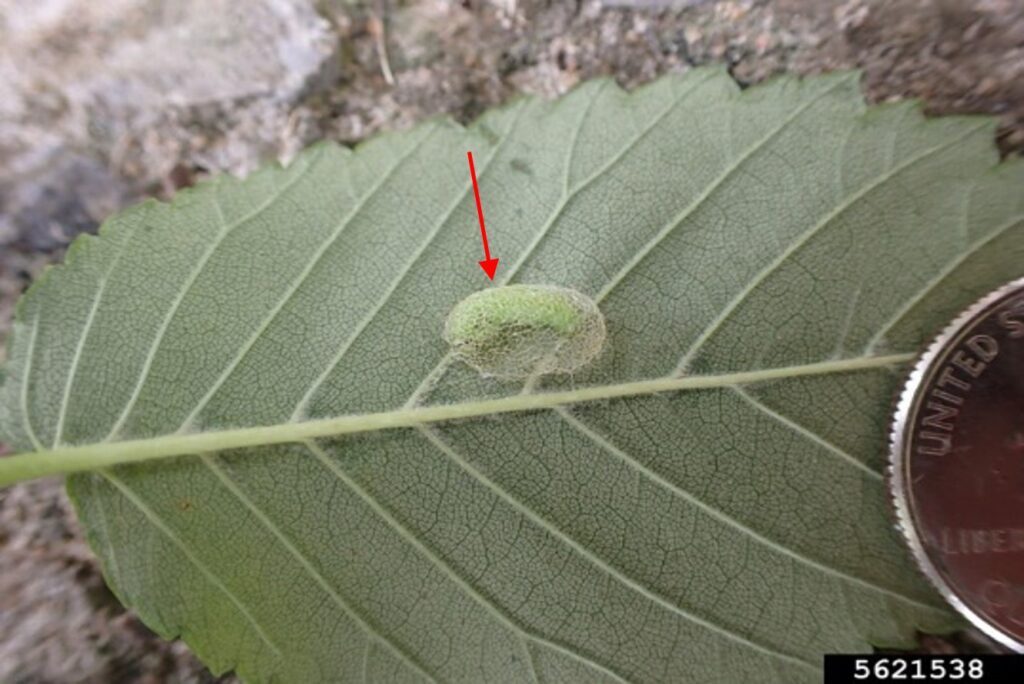The invasive elm zigzag sawfly (EZS, Aproceros leucopoda; Fig. 1), also known as East Asian sawfly, elm sawfly, and zigzag sawfly, is a small wasp native to Japan, Russia, China, and the Korean peninsula. In 2003, EZS was accidentally introduced to Europe. Since then, it has spread rapidly to many countries in Europe. In the US, EZS has been reported in nine states, where it continues to threaten elm trees. EZS larvae exclusively feed on the foliage of elm trees (Ulmus spp.), creating distinctive zigzag feeding patterns on the leaves (Fig. 2). Although EZS is considered a minor pest in Asia, it has caused severe localized defoliation on elm trees in Europe and the US. NOT REPORTED IN GA


Distribution
The EZS, native to East Asia, was first detected in North America from Québec, Canada, in the summer of 2020 when a Canadian citizen uploaded the feeding damage to the iNaturalist website. In the US, it was first found in Virginia in May of 2021, near Winchester in Frederick County, on Siberian elm (U. pumila) trees and has since been detected in many states, including Pennsylvania, North Carolina, Maryland, and New York in 2022. In 2023, EZA was founded in Massachusetts, Ohio, and Vermont; by 2024, it was founded in Minnesota. It is anticipated that EZS will continue to spread across the elm tree-growing regions of the US.
Several elm species occur in Georgia, especially in the northern region of Georgia. The major species of elm found in urban areas and upland forests of Georgia are American elm (U. americana), winged elm (U. alata), Chinese elm (U. parvifolia), and slippery elm (U. rubra). Chinese elm or lacebark elm (U. parvifolia) is widely planted in urban areas, especially parking lots and residential and public landscapes. Native elms, such as American elm and winged elm, are found in the foothills and mountainous regions of North Georgia, where temperatures are at a cooler spectrum. These regions are particularly at risk from EZS infestation.

Damage and symptoms
The EZS could threaten elm trees in both urban landscapes and forested regions. The EZS larvae are voracious defoliators, causing serious damage to the elm trees they infest. Initially, the larvae create a distinctive zigzag pattern (Fig. 2) when feeding on leaves. However, as feeding progresses, this pattern becomes less apparent, and the larvae often consume the entire leaf, leaving only the midrib behind (Fig. 3). Severe infestations can result in complete defoliation of trees. Over time, heavily infested trees may experience branch dieback and stunt growth in subsequent seasons. They rarely kill a tree.
Description
Adult EZS is 7- 8 mm long, shiny black wasps with pale legs and smoky-brown wings (Fig 1). Eggs are light green and < 1 mm and laid into the serrated edges of elm leaves. Young larvae have a near-uniform green and are easy to find within a zigzag pattern they create after feeding. Older larvae have a lateral stripe on each side of their head capsules that crosses their eyes (Fig 4. red arrow). The second and third pairs of true legs of older larvae have brown, sometimes incomplete, T-shaped markings (Fig 4. blue arrow). Older stage larvae are 10-11 mm long. When ready to pupate, they make cocoons. Cocoons are either net-like, loosely woven, typically attached to leaves, or dense solid-walled, often found in leaf litter or soil.

Life cycle
Adult females of EZS reproduce by laying unfertilized eggs. All the unfertilized eggs develop into females. Males are not reported for this species. Females begin to lay eggs as soon as they emerge from the pupal stage. They lay 7-49 eggs singly along the serrated margins of elm leaves. Eggs hatch within 4-8 days.
Larvae (Fig. 4) feed for 10-18 days and progress through six larval development stages (instars) before pupating. They pupate in net-like or solid-walled cocoons. During summer, cocoons are loosely woven and net-like, typically attached to leaves (Fig. 5), whereas overwintering cocoons are denser with solid walls, often found in leaf litter or soil. The summer adults emerge within 10 days of cocoon formation, whereas overwintering individuals remain in their cocoons until the following spring and emerge. The number of generations per year varies by region, with four to six generations reported from Europe. In Virginia, two generations were observed in 2021 and one in 2022. This suggests that generations are not completely sorted out in the US.

Host plants
Table 1. Host plants of EZS.
| Common Name | Scientific Name |
| American elm | U. americana |
| Winged elm | U. alata |
| Chestnut-leafed elm | U. castaneifolia |
| Japanese elm | U. davidiana |
| Mountain elm | U. glabra |
| Hairy-fruited Glaucescent Elm | U. glaucescens |
| Dutch elm | Ulmus × hollandica |
| Manchurian elm | U. laciniata |
| Russian white elm | U. laevis |
| Hebei elm | U. lamellose |
| European field elm | U. minor |
| Chinese elm | U. parvifolia |
| English elm | U. procera |
| Dwarf elm/ Siberian elm | U. pumila |
| Slippery elm | U. rubra |
| Hybrid elm | hybrid Ulmus x ‘Cathedral’ |
Monitoring
Both yellow and fluorescent yellow sticky “cloak” traps have proven effective in capturing large numbers of adult EZS. The adult EZS can spread up to 28-56 miles every year. The EZS can tolerate cold temperatures, with a supercooling point ranging from 10.4 to -11.2 °F in Europe, allowing it to survive harsh winters. Solitary elms in urban landscapes, newly planted trees, and those near roads or railways are particularly vulnerable to infestation. These characteristics make the EZS an excellent target for detection through community science initiatives.
Management
Currently, there is limited research available on the effective management of the EZS. In Europe, the application of deltamethrin and teflubenzuron successfully reduced first-generation larvae. Similarly, field trials with the entomopathogenic fungus, Beauveria bassiana reduced larval populations. Bioassays using foliar-applied dinotefuran also demonstrated high larval mortality.
Management techniques against other sawfly species may also be effective on EZS. For example, applying insecticidal soaps or horticultural oils when larvae are small can help suppress their infestation. Physical methods, such as hand-picking larvae or using a high-pressure water spray to dislodge larvae from trees, are simple yet effective tactics for mild infestation.
Report a sighting
We welcome reports of suspected sightings of elm zigzag sawfly to help us monitor its distribution and impacts. Please report it to the Georgia Department of Agriculture (https://agr.georgia.gov/form/contact-us?src=pest-control) or the University of Georgia Extension agent in your County. Report sightings in Georgia to us using our https://www.eddmaps.org/report/index.cfm pest reporting tool. Please include clear photos when submitting a report online.
References
Nețoiu, C., Tomescu, R., Olenici, N., Buzatu, A., Bălăcenoiu, F., Iliescu, O., 2018. The invasive insect species in the Oltenia region (Romania). Oltenia Journal for Studies in Natural Sciences, 34(1) 111-123. http://biozoojournals.ro/oscsn/cont/34_1/finalvol1.pdf
Aproceros leucopoda (APRCLE) [United States of America] | EPPO Global Database. (2024). Eppo.int. https://gd.eppo.int/taxon/APRCLE/distribution/US
Artokhin KS, Ignatova PK, Terskov EN. New insects including invasive species for the fauna of Rostov Region (Russia). Caucasian Entomol Bull. 2012:8:199–202.
Blank SM, Hara H, Mikulás J, Csóka G, Ciornei C, Constantineanu R, Constantineanu I, Roller L, Altenhofer E, Huflejt T, et al. Aproceros leucopoda (Hymenoptera, Argidae): an East Asian pest of elms (Ulmus spp.) invading Europe. Eur J Entomol. 2010:107(3):357–367. https://doi. org/10.14411/eje.2010.045
Del Pozo-Valdivia AI, Calpo D, Sutphin M. Effect of afidopyropen and dinotefuran on EZS control. Arthropod Manag Tests. 2021:47:1.
EPPO Global Database. (2020). Eppo.int. https://gd.eppo.int/reporting/article-6862
Fătu A–C, Cardaş G, Ciornei C, Andrei A–M. Experimental field application of Beauvaria bassiana (Bals.) Vuill. for control of the invasive sawfly Aproceros leucopoda Takeuki, 1939 (Hymenoptera: Argidae) in Romania. Acta Zool Bulg. 2020:72:661–666.
Holuša J, Stodůlková P, Macek J. Observations on the occurrence and phenology of the invasive elm defoliator Aproceros leucopoda (Hymenoptera: Argidae) in the Czech Republic. Urban For Urban Green. 2017:21:29–33.
Jones, P. and Comfort, D., 2019. Elm trees under attack again. Town and Country Planning, pp.71-74.
Martynoz VV, Nikulina TV. Population surge of zigzag elm sawfly (Aproceros leucopoda (Takeuchi, 1939): Hymenoptera: Argidae) in the Northern CizAzov Region. Russ J Biol Invasions. 2017:8:25–34.
Mol AWM, Vonk DH. De iepenzigzagbladwesp Aproceros leucopoda (Hymenoptera: Argidae), een invasieve exoot in Nederland. Entomol Ber. 2015:75:50–63.
NAPPO Phytosanitary Alert System. Official Pest Reports. Canada (2020-09-11) Aproceros leucopoda – elm zigzag sawfly detected in Québec. https://www.pestalerts.org/official-pest-report/aproceros-leucopoda-elm-zigzag-sawfly-detected-qu-bec-aproceros-leucopoda
Oten, K., Day, E., Dellinger, T., Disque, H., Barringer, L., Cancelliere, J., Somers, L., & Bertone, M. (2023). First records of elm zigzag sawfly (Hymenoptera: Argidae) in the United States. Journal of Integrated Pest Management, 14. https://doi.org/10.1093/jipm/pmad009
Sundukov, Y. I., 2009. The suborder Symphyta. In: Insects of the Lazovsky Reserve, [ed. by Storozhenko, S. Yu.]. Vladivostok, Russia: Dal’nauka. 212-220.
Vétek G, Csávás K, Fail J, Ladányi M. Host plant range of Aproceros leucopoda is limited within Ulmaceae. Agric For Entomol. 2022:24:1–7.
WU X.Y. & XIN H. 2006: A new recorded species of the genus Aproceros Malaise (Hymenoptera: Argidae) from China. Entomotaxonomia 28: 279–280 [in Chinese].
Wu XY. Studies on the biology and control of Aproceros leucopoda. Plant Prot. 2006:32:98–100.
Zandigiacomo P, Cargnus E, Villani A. First record of the invasive sawfly Aproceros leucopoda infesting elms in Italy. Bull Insectol. 2011:64:145–149.